Customer Acquisition and Customer Retention
Customer acquisition and customer retention are two metrics used mainly to determine the return on investment (ROI) for efforts to monetize consumers. Both are essential numbers to track since they will show shifts in the market or problems with a marketing plan. The numbers are different in a few ways.
Customer LTV Excel Calculator Template
Calculation Customer Acquisition Cost
Customer acquisition is the cost of converting a person into a paying customer. Determining the cost of acquisition requires dividing all expenses dedicated to acquisition by the number of new customers acquired over the same period. Acquisition expenses include marketing, promotions like discounts, labor and any advertising targeted at non-existing customers. High customer acquisition numbers could indicate demographic shifts, ineffective marketing or problems with core products and services.
Over recent years, brands across the world have seen customer acquisition costs rise. Many digital marketing platforms have added privacy elements that make it more difficult to collect customer data, causing an increase in customer acquisition costs. According to Vogue Business, some brands experienced as much as a 50 percent increase in costs. For example, the cost of advertising on Amazon increased by 30 percent from $0.93 per click to $1.20.

How to Calculate Customer Retention Costs
Customer retention is the cost of keeping an existing customer purchasing. Calculating retention costs is not easy. There is no commonly accepted formula. Retention figures can be calculated using total purchases over a period mitigated by retention expenditures, churn, acquisition costs and general overhead. Once retention figures are collected, the most accepted formula is to divide the costs by the number of active customers during the analyzed period.
Customer Retention Cost = Total Costs Attributed to Retention Programs / Active Customers during the period
Customer retention directly affects lifetime values (LTV). High retention costs lower margins and profits since each subsequent purchase is actually worth less overall.
Balancing Customer Acquisition Cost & Customer Retention Cost
Every business needs to balance acquisition and retention costs. Acquisition is important to draw in new consumers and expand the base. Retention is normally less costly and builds loyalty and the brand. Retention also often relies on far less price sensitivity from customers so that the long-term costs are recouped through sales. It is essential to track the ROI for both customer acquisition and customer retention. Poor ratios in either area are strong indicators that more research is necessary to see what is changing in the market or what is happening within the business.
Customer Lifetime Value Excel Calculator
Download this Excel-based template for a fast and easy method to calculate your customers’ lifetime value.
Customer Acquisition and Retention During Peak Times
It is essential to balance customer acquisition and retention to gain the most lifetime value. Marketers tend to focus on customer acquisition during peak shopping times such as holidays, Black Friday, Back to School season, and more. However, customer acquisition is not the best strategy to use during these times. During the peak shopping seasons, it is important to focus more attention on existing customers than potential customers. People who shop at your store once during the holiday season are less likely to shop again at your store. Demonstrating that acquisition during peak times is not the best strategy. Furthermore, existing customers spend and buy more than new customers and customer reactivation is higher during these times. It is important to find a balance between acquisition and retention that works for you but, especially during peak times, it is important to remember the value of existing customers.
Why Do Marketers Prefer Retention Over Acquisition?
Data shows the retaining existing customers is equally, if not more important than acquiring new customers. The cost of acquiring new customers is five times higher than the cost of retaining existing customers. While acquisition allows you to increase the amount of customers you have, customer retention allows you to maximize the value of customers you have already captured.

Optimove’s Customer Acquisition & Retention Software
Optimove combines predictive customer modeling and advanced multi-channel campaign automation technologies to help businesses maximize customer loyalty, retention and lifetime value. Contact us today – or request a Web demo – to learn how you can use Optimove to acquire more customers, increase the spend of existing customers and reduce customer churn.
Frequently asked questions:
Why are customer acquisition costs typically higher than customer retention costs?
The cost of acquiring a new customer can be as much as five times higher than retaining an existing one. Customer Acquisition Costs (CAC) are typically higher than Customer Retention Costs due to the extensive marketing and advertising efforts required to attract new customers. Acquisition involves broad strategies such as digital advertising, content marketing, social media campaigns, and more, which are aimed at reaching a broad audience to find potential customers. These activities often require significant investment in both time and money. On the other hand, retention costs focus on maintaining and deepening relationships with existing customers through email marketing, customer service, loyalty programs, and personalized offers. Since these efforts are directed at an already engaged audience, they are more cost-effective and require less financial outlay compared to the broad and competitive field of acquiring new customers.
How can understanding the ratio of customer acquisition cost to customer retention cost benefit a business?
Understanding the ratio of Customer Acquisition Cost (CAC) to Customer Retention Cost can provide valuable insights into a business’s marketing efficiency and customer relationship management. A lower ratio indicates that a company effectively retains customers at a lower cost than the cost of acquiring new ones, which can lead to increased profitability over time. Conversely, a high ratio might suggest that the business is spending too much on acquisition compared to retention, which could be unsustainable in the long term. By analyzing this ratio, businesses can make informed decisions about allocating their marketing budget to optimize both acquisition and retention strategies, ensuring a balanced approach that supports sustainable growth and profitability. This analysis helps identify opportunities for improvement in both areas and strikes the right balance between attracting new customers and keeping existing ones engaged.
Get a personalized tour of Optimove
Let us show you how to go from tens to hundreds of segments


